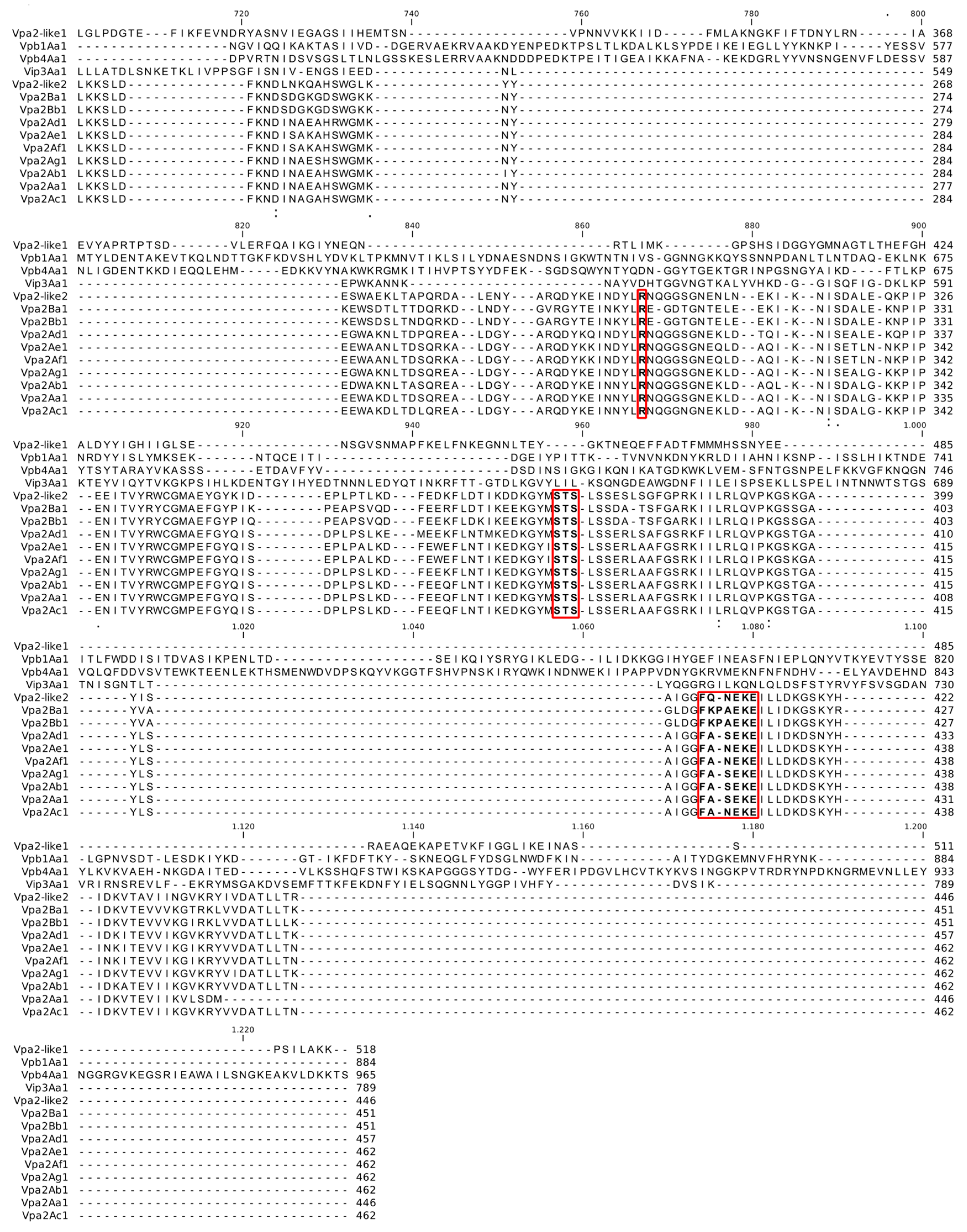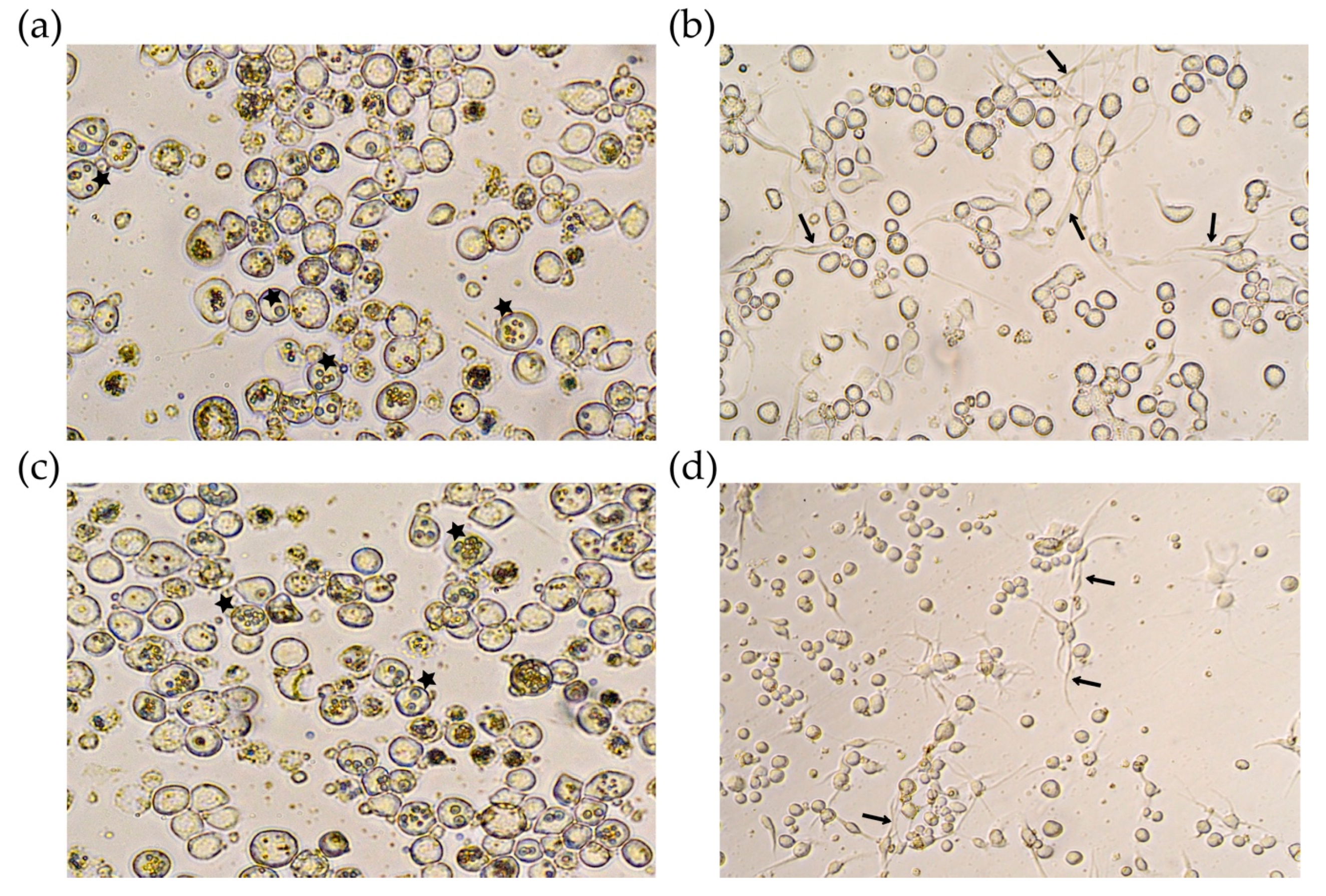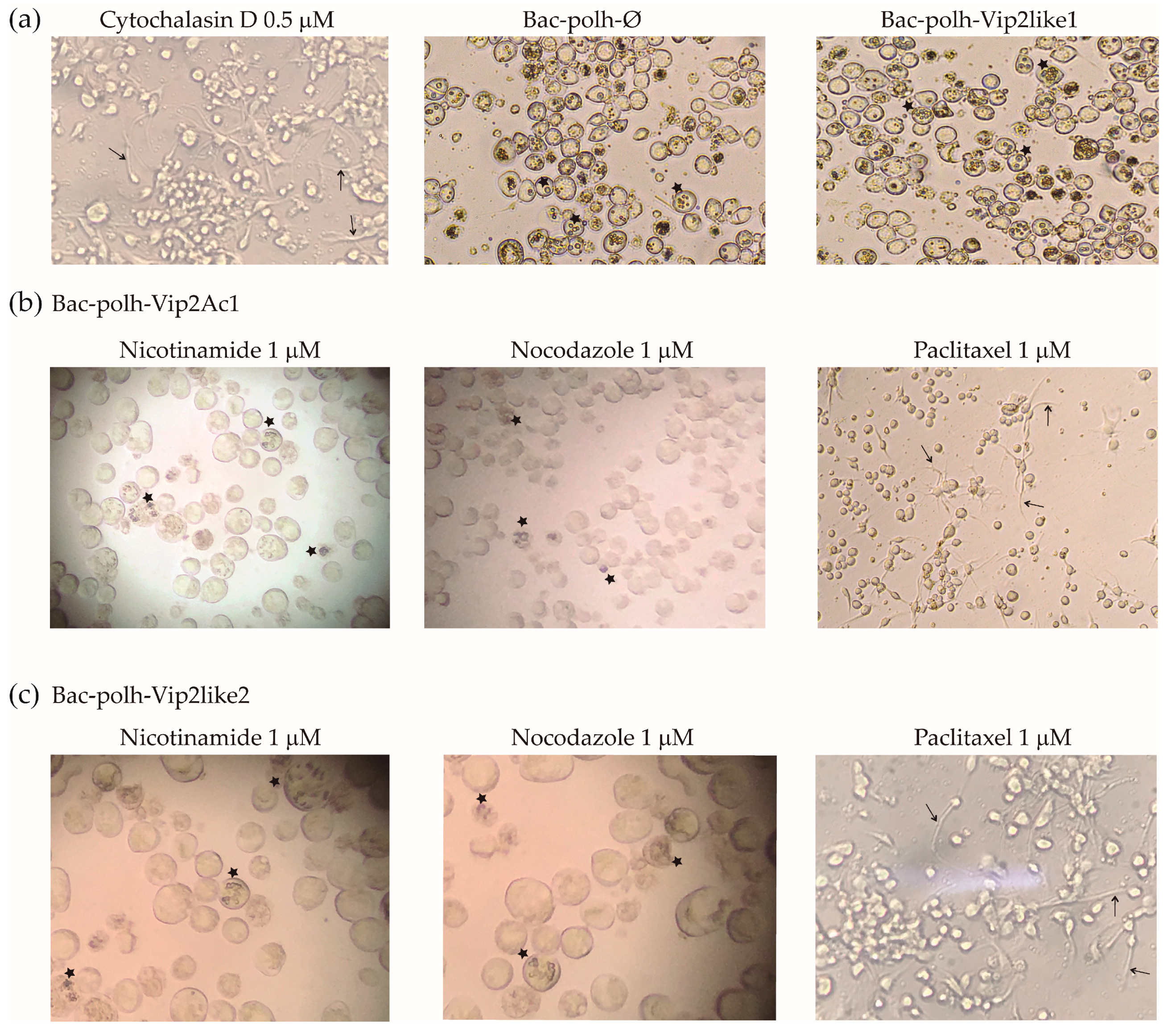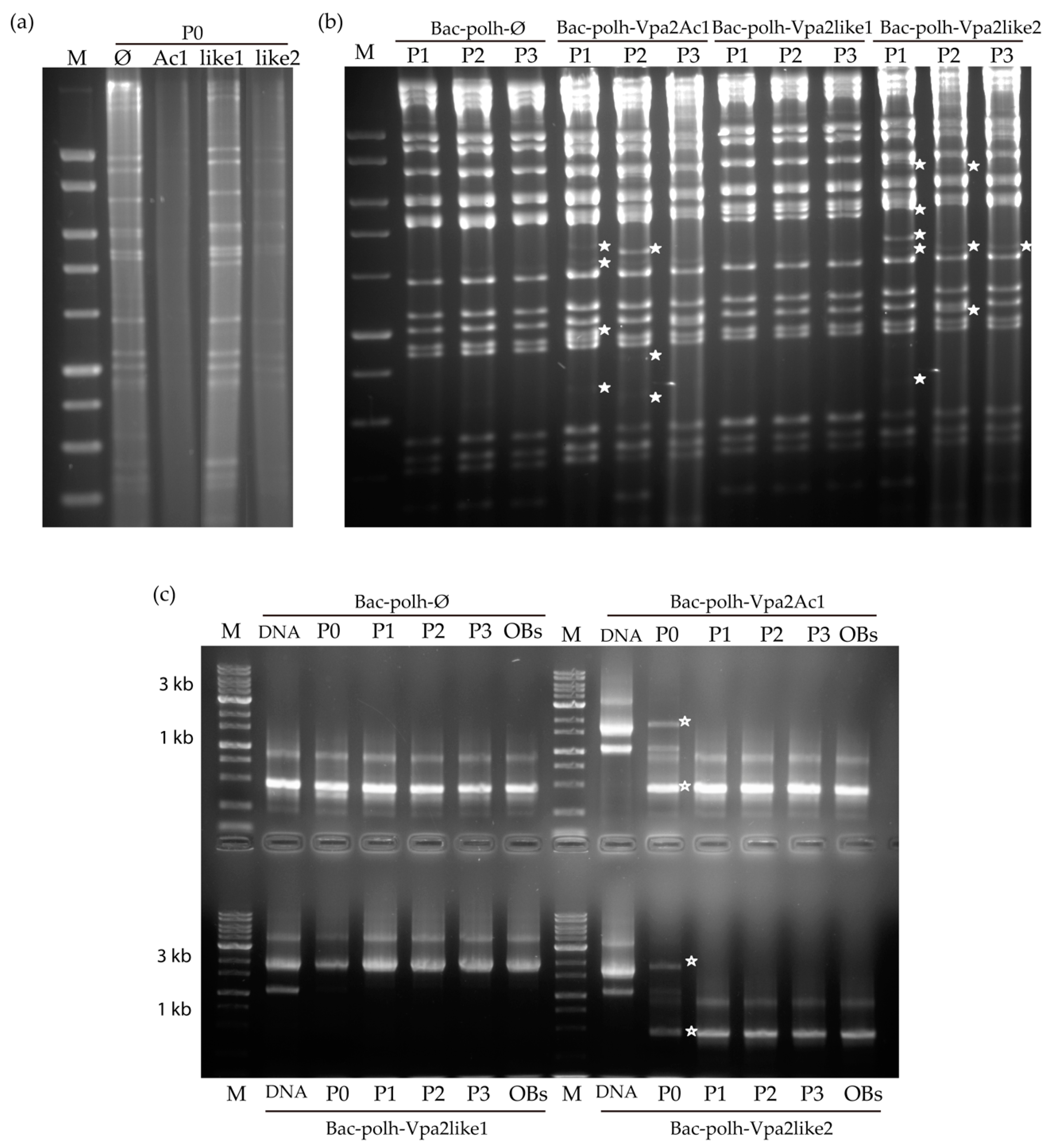Baculovirus Expression and Functional Analysis of Vpa2 Proteins from Bacillus thuringiensis
Abstract
:1. Introduction
2. Results
2.1. Vpa2 Protein Sequence Analysis
2.2. Transfection of Sf9 Cells with Recombinant Bac-polh-Vpa2Ac1, Bac-polh-Vpa2like1, Bac-polh-Vpa2like2 and Bac-polh-Ø virus DNAs
2.3. Detection of Vpa2 Transcripts and Proteins in Transfected Cells
2.4. Effect of Actin-Modulating Compounds on Viral Transfection
2.5. Biological Activity of Recombinant Viruses Expressing Vpa2Ac1, Vpa2-like1 and Vpa-like2
3. Discussion
4. Conclusions
5. Materials and Methods
5.1. Vpa2 Protein Analysis
5.2. Construction of Recombinant Viruses Expressing Vpa2Ac1, Vpa2-like1 and Vpa2-like2 Proteins
5.3. Transfection of Sf9 Cells with Recombinant Viruses
5.4. Detecting Vpa2Ac1, Vpa2-like1 and Vpa2-like2 Transcripts and Proteins in Transfected Cells
5.5. Effects of Actin-Affecting Agents on Cell Morphology
5.6. Determining the Insecticidal Characteristics of Recombinant Viruses
Supplementary Materials
Author Contributions
Funding
Acknowledgments
Conflicts of Interest
References
- Aktories, K.; Lang, A.E.; Schwan, C.; Mannherz, H.G. Actin as target for modification by bacterial protein toxins. FEBS J. 2011, 278, 4526–4543. [Google Scholar] [CrossRef]
- Alberts, B.; Johnson, A.; Lewis, J.; Raff, M.; Roberts, K.; Walter, P. Molecular Biology of the Cell, 4th ed.; Garland Science: New York, NY, USA, 2002. [Google Scholar]
- Rodríguez, O.C.; Shaefer, A.W.; Mandato, C.A.; Forcher, P.; Bement, W.M.; Waterman-Storer, C.M. Conserved microtubule-actin interactions in cell movement and morphogenesis. Nat. Cell Biol. 2003, 5, 599–609. [Google Scholar] [CrossRef]
- Aktories, K.; Barbieri, J.T. Bacterial cytotoxins: Targeting eukaryotic switches. Nat. Rev. Microbiol. 2005, 3, 397–410. [Google Scholar] [CrossRef]
- Barbieri, J.T.; Riese, M.J.; Aktories, K. Bacterial toxins that modify the actin cytoskeleton. Annu. Rev. Cell Dev. Biol. 2002, 18, 315–344. [Google Scholar] [CrossRef] [PubMed]
- Simon, N.; Aktories, K.; Barberi, J.T. Novel bacterial ADP-ribosylating toxins: Structure and function. Nat. Rev. Microbiol. 2014, 12, 599–611. [Google Scholar] [CrossRef] [PubMed]
- Ferh, D.; Burr, S.E.; Gibert, M.; d’Alayer, J.; Frey, J.; Popoff, M.R. Aeromonas exoenzyme T of Aeromonas salmonicida is a bifunctional protein that targets the host cytoskeleton. J. Biol. Chem. 2007, 282, 28843–28852. [Google Scholar] [CrossRef]
- Hochmann, H.; Pust, S.; von Figura, G.; Aktories, K.; Barth, H. Salmonella enterica SpvBADP-ribosylates actin at position arginine-177-characterization of the catalytic domain within the SpvB protein and a comparison to binary clostridial actin-ADP-ribosylating toxins. Biochemistry 2006, 45, 1271–1277. [Google Scholar] [CrossRef]
- Vandekerckhove, J.; Schering, B.; Bärmann, M.; Aktories, K. Botulinum C2 toxin ADP-ribosylates cytoplasmic beta/gamma-actin in arginine 177. J. Biol. Chem. 1988, 263, 696–700. [Google Scholar]
- Visschedyk, D.D.; Perieteanu, A.A.; Turgeon, Z.J.; Fieldhouse, R.J.; Dawson, J.F.; Merrill, A.R. Photox, a novel actin-targeting mono-ADP-ribosyltransferase from Photorhabdus luminescens. J. Biol. Chem. 2010, 285, 13525–13534. [Google Scholar] [CrossRef]
- Wiegers, W.; Just, I.; Müller, H.; Hellwig, A.; Traub, P.; Aktorties, K. Alteration of the cytoskeleton of mammalian cells cultured in vitro by Clostridium botulinum C2 toxin and C3 ADP-ribosyltransferase. Eur. J. Cell Biol. 1991, 54, 237–245. [Google Scholar]
- Schwan, C.; Stecher, B.; Tzivelekidis, T.; van Ham, M.; Rohde, M.; Hardt, W.D.; Wehland, J.; Aktories, K. Clostridium difficile toxin CDT induces formation of microtubule-based protrusions and increases adherence of bacteria. PLoS Pathog. 2009, 5, e1000626. [Google Scholar] [CrossRef] [PubMed]
- Uematsu, Y.; Kogo, Y.; Ohishi, I. Disassembly of actin filaments by botulinum C2 toxin and actin-filament-disrupting agents induces assembly of microtubules in human leukaemia cell lines. Biol. Cell 2007, 99, 141–150. [Google Scholar] [CrossRef] [PubMed]
- Whipple, R.A.; Cheung, A.M.; Martin, S.S. Detyrosinated microtubule protrusions in suspended mammary epithelial cells promote reattachment. Exp. Cell Res. 2007, 313, 1326–1336. [Google Scholar] [CrossRef] [PubMed]
- Chakroun, M.; Banyuls, N.; Bel, Y.; Escriche, B.; Ferré, J. Bacterial vegetative insecticidal proteins (Vip) from entomopathogenic bacteria. Microbiol. Mol. Biol. Rev. 2016, 80, 329–350. [Google Scholar] [CrossRef] [PubMed]
- Palma, L.; Muñoz, D.; Berry, C.; Murillo, J.; Caballero, P. Bacillus thuringiensis toxins: An overview of their biological activity. Toxins 2014, 6, 3296–3325. [Google Scholar] [CrossRef] [PubMed]
- Mendoza-Almanza, G.; Esparza-Ibarra, E.L.; Ayala-Luján, J.L.; Mercado-Reyes, M.; Godina-González, S.; Hernández-Barrales, M.; Olmos-Soto, J. The cytocidal spectrum of Bacillus thuringiensis toxins: From insects to human cancer cells. Toxins 2020, 12, 301. [Google Scholar] [CrossRef]
- Crickmore, N.; Baum, J.; Bravo, A.; Lereclus, D.; Narva, K.; Sampson, K.; Schnepf, E.; Sun, M.; Zeigler, D.R. Bacillus thuringiensis toxin nomenclature. Available online: http://www.btnomenclature.info (accessed on 25 October 2019).
- Crickmore, N.; Berry, C.; Panneerselvam, S.; Mishra, R.; Connor, T.R.; Bonning, B.C. A structure-based nomenclature for Bacillus thuringiensis and other bacteria-derived pesticidal proteins. J. Invertebr. Pathol. 2020, 107438. [Google Scholar] [CrossRef]
- Barth, H.; Aktories, K.; Popoff, M.R.; Stiles, B.G. Binary bacterial toxins: Biochemistry, biology, and applications of common Clostridium and Bacillus proteins. Microbiol. Mol. Biol. Rev. 2004, 68, 373–402. [Google Scholar] [CrossRef]
- Han, S.; Tainer, J.A. The ARTT motif and a unified structural understanding of substrate recognition in ADP-ribosylating bacterial toxins and eukaryotic ADP-ribosyltransferases. Int. J. Med. Microbiol. 2001, 291, 523–529. [Google Scholar] [CrossRef]
- Sakurai, J.; Nagahama, M.; Oda, M.; Tsuge, H.; Kobayashi, K. Clostridium perfringens iota-toxin: Structure and function. Toxins 2009, 1, 208–228. [Google Scholar] [CrossRef]
- Shi, Y.; Ma, W.; Yuan, M.; Sun, F.; Pang, Y. Cloning of Vpa1/Vpa2 genes and expression of Vpa1Ca/Vpa2Ac proteins in Bacillus thuringiensis. World J. Microbiol. Biotechnol. 2006, 23, 501–507. [Google Scholar] [CrossRef]
- Shi, Y.; Xu, W.; Yuan, M.; Tang, M.; Chen, J.; Pang, Y. Expression of Vpa1/Vpa2 genes in Escherichia coli and Bacillus thuringiensis and the analysis of their signal peptides. J. Appl. Microbiol. 2004, 97, 757–765. [Google Scholar] [CrossRef] [PubMed]
- Geng, J.; Jiang, J.; Shu, C.; Wang, Z.; Song, F.; Geng, L.; Duan, J.; Zhang, J. Bacillus thuringiensis Vpa1 functions as a receptor of Vpa2 toxin for binary insecticidal activity against Holotrichia parallela. Toxins 2019, 11, 440. [Google Scholar] [CrossRef] [PubMed]
- Warren, G.W.; Koziel, M.G.; Mullins, M.A.; Nye, G.J.; Carr, B.; Desai, N.M.; Kostichka, K.; Duck, N.B.; Estruch, J.J. Auxiliary proteins for enhancing the insecticidal activity of pesticidal proteins. U.S. Patent US5770696A, 23 June 1998. [Google Scholar]
- Sattar, S.; Maiti, M.K. Molecular characterization of a novel vegetative insecticidal protein from Bacillus thuringiensis effective against sap-sucking insect pest. J. Microbiol. Biotechnol. 2011, 21, 937–946. [Google Scholar] [CrossRef] [PubMed]
- Kasman, L.M.; Volkman, L.E. Filamentous actin is required for lepidopteran nucleopolyhedrovirus progeny production. J. Gen. Virol. 2000, 81, 1881–1888. [Google Scholar] [CrossRef] [PubMed]
- Ohkawa, T.; Volkman, L.E. Nuclear F-actin is required for AcMNPV nucleocapsid morphogenesis. Virology 1999, 264, 1–4. [Google Scholar] [CrossRef]
- Volkman, L.E. Baculovirus infectivity and the actin cystokeleton. Curr. Durg Targ. 2007, 8, 1075–1083. [Google Scholar] [CrossRef]
- Palma, L.; Ruiz de Escudero, I.; Maeztu, M.; Caballero, P.; Muñoz, D. Screening of Vip genes from a Spanish Bacillus thuringiensis collection and characterization of two novel Vpa3 proteins highly toxic to five lepidopteran crop pests. Biol. Control 2013, 66, 141–149. [Google Scholar] [CrossRef]
- Iriarte, J.; Bel, Y.; Ferrandis, M.D.; Andrew, R.; Murillo, J.; Ferré, J.; Caballero, P. Environmental distribution and diversity of Bacillus thuringiensis in Spain. Syst. Appl. Microbiol. 1998, 21, 97–106. [Google Scholar] [CrossRef]
- Myers, K.A.; He, Y.; Hasake, T.P.; Baas, P.W. Microtubule transport in the axon: Re-thinking a potential role for actin cytoskeleton. Neuroscientist 2006, 12, 107–118. [Google Scholar] [CrossRef]
- Malovichko, Y.V.; Nizhnikov, A.A.; Antonets, K.S. Repertoire of the Bacillus thuringiensis virulence factors unrelated to major classes of protein toxins and its role in specificity of host-pathogen interactions. Toxins 2019, 11, 347. [Google Scholar] [CrossRef] [PubMed]
- Talhouk, S.N.; Volkman, L.E. Autographa californica M nuclear polyhedrosis virus and cytochalasin D: Antagonists in the regulation of protein synthesis. Virology 1991, 182, 626–634. [Google Scholar] [CrossRef]
- Volkman, L.E.; Talhouk, S.N.; Oppenheimer, D.I.; Charlton, C.A. Nuclear F-actin: A functional component of baculovirus-infected lepidopteran cells? J. Cell Sci. 1992, 103, 15–22. [Google Scholar]
- Spear, M.; Wu, Y. Viral exploitation of actin: Force-generation and scaffolding functions in viral infection. Virol. Sin. 2014, 29, 139–147. [Google Scholar] [CrossRef] [PubMed]
- Fang, M.; Nie, Y.; Theilmann, D.A. AcMNPV EXON0 (AC141) which is required for the efficient egress of budded virus nucleocapsids interacts with ß-tubulin. Virology 2009, 385, 496–504. [Google Scholar] [CrossRef] [PubMed]
- Ohkawa, T.; Volkman, L.E.; Welch, M.D. Actin-based motility drives baculovirus transit to the nucleus and cell surface. J. Cell Biol. 2010, 190, 187–195. [Google Scholar] [CrossRef] [PubMed]
- Willemsen, A.; Zwart, M.P. On the stability of sequences inserted into viral genomes. Virus Evol. 2019, 5, vez045. [Google Scholar] [CrossRef]
- Pijlman, T.C.; van den Born, E.; Martens, D.E.; Vlak, J.M. Autographa californica baculoviruses with large genomic deletions are rapidly generated in infected insect cells. Virology 2001, 283, 132–138. [Google Scholar] [CrossRef]
- Pijlman, G.P.; Dortmans, J.C.F.M.A.; Vermeesch, M.G.; Yang, K.; Martens, D.E.; Goldbach, R.W.; Vlak, J.M. Pivotal role of the non-hr origin of DNA replication in the genesis of defective interfering baculoviruses. J. Virol. 2002, 76, 5605–5611. [Google Scholar] [CrossRef]
- Pijlman, G.P.; van Schijndel, J.E.; Vlak, J.M. Spontaneous excision of BAC vector sequences from bacmid-derived baculovirus expression vectors upon passage in insect cells. J. Gen. Virol. 2003, 84, 2669–2678. [Google Scholar] [CrossRef]
- Simón, O.; Williams, T.; Possee, R.D.; López-Ferber, M.; Caballero, P. Stability of a Spodoptera frugiperda nucleopolyhedrovirus deletion recombinant during serial passage in insects. Appl. Env. Microbiol. 2010, 76, 803–809. [Google Scholar] [CrossRef] [PubMed]
- Cory, J.S.; Myers, J.H. The ecology and evolution of insect baculoviruses. Ann. Rev. Ecol. Evol. Syst. 2003, 34, 239–272. [Google Scholar] [CrossRef]
- Domenighini, M.; Rappuoli, R. Three conserved consensus sequences identify the NAD-binding site of ADP-ribosylating enzymes, expressed by eukaryotes, bacteria and T-even bacteriophages. Mol. Microbiol. 1996, 21, 667–675. [Google Scholar] [CrossRef]
- Deist, B.R.; Rausch, M.A.; Fernández-Luna, M.T.; Adang, M.J.; Bonning, B.C. Bt toxin modification for enhanced efficacy. Toxins 2014, 6, 3005–3027. [Google Scholar] [CrossRef] [PubMed]
- Sievers, F.; Wilm, A.; Dineen, D.; Gibson, T.J.; Karplus, K.; Li, W.; López, R.; McWilliam, H.; Remmert, M.; Söding, J.; et al. Fast, scalable generation of high-quality protein multiple sequence alignments using Clustal Omega. Mol. Syst. Biol. 2011, 7, 539. [Google Scholar] [CrossRef] [PubMed]
- Darriba, D.; Taboada, G.L.; Doallo, R.; Posada, D. ProtTest 3: Fast selection of best-fit models of protein evolution. Bioinformatics 2011, 27, 1164–1165. [Google Scholar] [CrossRef]
- Stamatakis, A. RAxML Version 8: A tool for phylogenetic analysis and post-analysis of large phylogenies. Bioinformatics 2014, 30, 1312–1313. [Google Scholar] [CrossRef]
- Jones, P.; Binns, D.; Chang, H.Y.; Fraser, M.; Weizhong, L.; McAnulla, C.; Pesseat, S.; Quinn, A.F.; Sangrador-Vegas, A.; Scheremetjew, M.; et al. InterProScan 5: Genome-scale protein function classification. Bioinformatics 2014, 30, 1236–1240. [Google Scholar] [CrossRef]
- Luckow, V.A.; Lee, C.; Barry, G.F.; Olins, P.O. Efficient generation of infectious recombinant baculoviruses by site-specific transposon-mediated insertion of foreign genes into a baculovirus genome propagated in Escherichia coli. J. Virol. 1993, 67, 4566–4579. [Google Scholar] [CrossRef]
- King, L.A.; Possee, R.D. The Baculovirus Expression System. A Laboratory Guide; Chapman & Hall: London, UK, 1992. [Google Scholar]
- Simón, O.; Williams, T.; López-Ferber, M.; Caballero, P. Genetic structure of a Spodoptera frugiperda nucleopolyhedrovirus population: High prevalence of deletion genotypes. Appl. Env. Microbiol. 2004, 70, 5579–5588. [Google Scholar] [CrossRef]
- Sambrook, J.; Russell, D.W. Molecular Cloning: A Laboratory Manual, 3rd ed.; Cold Spring Harbor Laboratory Press: New York, NY, USA, 2001. [Google Scholar]
- Hughes, P.R.; Wood, H.A. A synchronous per oral technique for the bioassay of insect viruses. J. Invertebr. Pathol. 1981, 37, 154–159. [Google Scholar] [CrossRef]
- LeOra Software. POLO-PC: A User’s Guide to Probit or Logit Analysis; LeOra Software: Berkeley, CA, USA, 1987. [Google Scholar]
- Katoh, K.; Standley, D.M. MAFFT multiple sequence alignment software version 7: Improvements in performance and usability. Mol. Biol. Evol. 2013, 30, 772–780. [Google Scholar] [CrossRef] [PubMed]





| Insect Species | Virus | LC50 (OBs/mL) | Relative Potency | Fiducial Limits (95%) | |
|---|---|---|---|---|---|
| Lower | Upper | ||||
| M. brassicae | Bac-polh-ø | 6.79 × 106 | 1 | - | - |
| Bac-polh-Vpa2Ac1 | 1.23 × 107 | 0.55 | 0.35 | 0.87 | |
| Bac-polh-Vpa2like1 | 2.36 × 107 | 0.29 | 0.17 | 0.50 | |
| Bac-polh-Vpa2like2 | 6.51 × 106 | 1.04 | 0.66 | 1.64 | |
| S. exigua | Bac-polh-ø | 2.97 × 105 | 1 | - | - |
| Bac-polh-Vpa2Ac1 | 6.18 × 105 | 0.48 | 0.30 | 0.76 | |
| Bac-polh-Vpa2like1 | 1.00 × 105 | 0.30 | 0.19 | 0.47 | |
| Bac-polh-Vpa2like2 | 6.14 × 105 | 0.48 | 0.30 | 0.77 | |
| S. littoralis | Bac-polh-ø | 1.24 × 107 | 1 | - | - |
| Bac-polh- Vpa2Ac1 | 1.47 × 107 | 0.84 | 0.50 | 1.40 | |
| Bac-polh-Vpa2like1 | 3.17 × 107 | 0.39 | 0.23 | 0.68 | |
| Bac-polh-Vpa2like2 | 1.107 × 107 | 1.13 | 0.70 | 1.82 | |
| S. frugiperda | Bac-polh-ø | 8.43 × 105 | 1 | - | - |
| Bac-polh- Vpa2Ac1 | 1.03 × 106 | 0.82 | 0.53 | 1.24 | |
| Bac-polh-Vpa2like1 | 4.83 × 106 | 0.18 | 0.12 | 0.26 | |
| Bac-polh-Vpa2like2 | 1.53 × 106 | 0.55 | 0.35 | 0.86 | |
| Primer | Sequence (Position in the Genome) | Amplification Purpose |
|---|---|---|
| BB.Vpa2Ac1-F | 5′-CCGCTCGAGATGCATCATCATCATCATCACAATTCTCAAAATAAATATAC-3′ | Vpa2Ac1 amplification. TF037.2 isolate was used as template. Underlined the XhoI site and Hig-tag sequence. |
| BB.Vpa2Ac1-R | 5′-CTAGCTAGCTTAATTTGTTAATAATGTTGCATCCACTACATATCGCTTAAC-3′ | Vpa2Ac1 amplification. TF037.2 isolate was used as template. Underlined the NheI site. |
| BB.Vpa2like1-F | 5′-CCGCTCGAGATGCATCATCATCATCATCACGAGAATTGGGATCCAATAAG-3′ | Vpa2-like1 amplification. H001.5 isolate was used as template. Underlined the XhoI site and Hig-tag sequence |
| BB.Vpa2like1-R | 5′-TAGCTAGCTTATTTTTTCGCTAGAATGGAAGGTGAACTAGCGTTTATTTC-3′ | Vpa2-like1 amplification. H001.5 isolate was used as template. Underlined the NheI site. |
| BB.Vpa2like2-F | 5′-CCGCTCGAGATGCATCATCATCATCATCACTATTCTGGTAAGAAACTAAATC-3′ | Vpa2-like2 amplification. H26.2 isolate was used as template. Underlined the XhoI site and Hig-tag sequence. |
| BB.Vpa2like2-R | 5′-CTAGCTAGCCTATCTTGTTAGCAAAGTTGCATCTACTATATATCTCTTGACG-3′ | Vpa2-like1 amplification. H26.2 isolate was used as template. Underlined the NheI site. |
| p10x.F | 5’-GTAGATCTTGTTGTCGTACA-3’ | Forward primer that annealed outside the coding region of the p10 promoter (within the polyhedrin gene) in the pFBD-phph-p10x. |
| p10x.R | 5’-TTATTGCCGTCATAGCGCGG-3’ | Reverse primer that annealed outside the coding region of the p10 promoter in the pFBD-phph-p10x. |
| Vpa2Ac1-R | 5’-CAATCAAAGAAGACAAAGGA-3’ | Reverse primer located 260 nt upstream of the Vpa2Ac1 stop codon. For Vpa2Ac1 transcript detection. |
| Vpa2-like1-R | 5’-ATTCAGGCGTTTCGAATATG-3’ | Reverse primer located 242 nt upstream of the Vpa2-like1 stop codon. For Vpa2-like1 transcript detection. |
| Vpa2-like2-R | 5’- TTAGATACAATTAAGGATGA -3’ | Reverse primer located 267 nt upstream of the Vpa2-like2 stop codon. For Vpa2-like1 transcript detection. |
© 2020 by the authors. Licensee MDPI, Basel, Switzerland. This article is an open access article distributed under the terms and conditions of the Creative Commons Attribution (CC BY) license (http://creativecommons.org/licenses/by/4.0/).
Share and Cite
Simón, O.; Palma, L.; Fernández, A.B.; Williams, T.; Caballero, P. Baculovirus Expression and Functional Analysis of Vpa2 Proteins from Bacillus thuringiensis. Toxins 2020, 12, 543. https://doi.org/10.3390/toxins12090543
Simón O, Palma L, Fernández AB, Williams T, Caballero P. Baculovirus Expression and Functional Analysis of Vpa2 Proteins from Bacillus thuringiensis. Toxins. 2020; 12(9):543. https://doi.org/10.3390/toxins12090543
Chicago/Turabian StyleSimón, Oihane, Leopoldo Palma, Ana Beatriz Fernández, Trevor Williams, and Primitivo Caballero. 2020. "Baculovirus Expression and Functional Analysis of Vpa2 Proteins from Bacillus thuringiensis" Toxins 12, no. 9: 543. https://doi.org/10.3390/toxins12090543
APA StyleSimón, O., Palma, L., Fernández, A. B., Williams, T., & Caballero, P. (2020). Baculovirus Expression and Functional Analysis of Vpa2 Proteins from Bacillus thuringiensis. Toxins, 12(9), 543. https://doi.org/10.3390/toxins12090543







